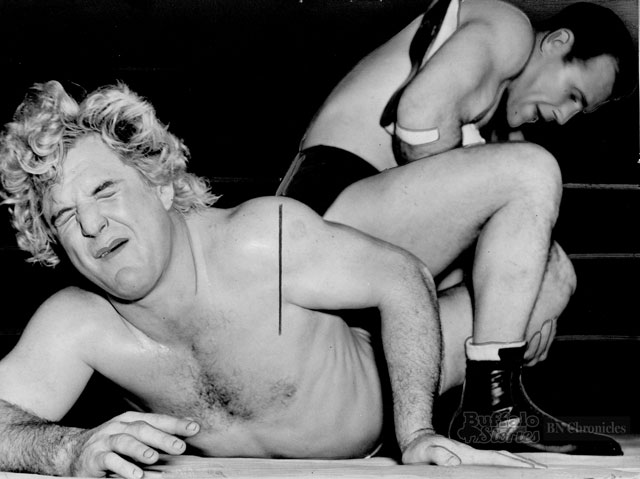 By Steve Cichon
By Steve Cichon
steve@buffalostories.com
@stevebuffalo

Excerpt from 100 Years of Buffalo Broadcasting
Starting in 1949, Friday night meant Ralph Hubbell, Chuck Healy, and TVs tuned to live wrestling from Memorial Auditorium—with the action and antics of folks like Gorgeous George, Ilio DiPaolo, Dick “The Destroyer” Beyer, Coco Brazil, and the Gallagher Brothers and dozens of others.
During pre- and post-match interviews, the athletic Healy would often find himself somehow entangled with the wrestlers he was trying to interview— handling the headlocks from “bad guys” with the grace of a professional broadcaster.
There’s little question—especially in Buffalo, wrestling helped make TV and vice-versa in those early years.
In 1951, Ed Don George was promoting wresting in 30 cities, including Buffalo. “Let them try to besmirch the wrestling profession as much as they’d like,” said Ed Don, “But what other form of sporting entertainment gives as much to the fans as wrestling?”
He was proud of wrestling’s showmanship, which had blossomed since he had been the world’s heavyweight champ 20 years earlier. “Sure, there is showmanship in wrestling. We try to dress up our business just like the downtown merchant decorates his shop windows to attract customers.”

Wrestling, of course, goes way back in Buffalo. Crowds sold out Friday night matches through the 30s, 40s, and 50s; first at the old Broadway Auditorium (now “The Broadway Barns” and the home of Buffalo’s snowplows) and then Memorial Auditorium when it opened in 1940.
“This was a shirt and tie crowd,” said the late Buffalo News Sports Editor Larry Felser, who remembered when Wrestling at the Aud was one of the biggest events in Buffalo.
“Not that many people had TV sets back then,” remembered Felser in 2001. “People were crowding into Sears and appliance stores to try to see this thing on TV, because the place was sold out.”
And with all those big crowds, there was no wrestler who could draw them in like Gorgeous George.

“When Gorgeous George would wrestle, they’d pack the Auditorium for this guy,” said Felser.
“The Human Orchid,” as George was known, was the first modern wrestler, said retired Channel 7 sports director Rick Azar, saying he “changed the face of professional wrestling forever.”
As someone who called himself “Hollywood’s perfumed and marcelled wrestling orchid,” it’s clear that George knew how to make sure he set himself apart.
“He had an atomizer, and he’d walk around the ring with perfume, supposedly fumigating his opponent’s corners,” said Felser, who also remembered George’s flair for marketing outside the ring.
“His valet drove him around in an open convertible around Lafayette Square, and he’s got a wad of one-dollar bills, and he was throwing money to people. It was a show stopper. He landed on page one. TV was just in its infancy then, but they were all over it. It was like World War III. That’s how big a story it was.”
Gorgeous George is credited with ushering in the Bad Boy era of sports– and even inspired Muhammad Ali, who told a British interviewer, “he was telling people, ‘I am the prettiest wrestler, I am great. Look at my beautiful blond hair.’ I said, this is a good idea, and right away, I started saying, ‘I am the greatest!’”
Wrestling was cheap, flashy and easy to televise — and Gorgeous George was the performer that people loved to hate. It was said that in TV’s earliest years, Gorgeous George’s appearance on TV sold as many televisions as Milton Berle’s.

Another of TV’s favorite early sports was bowling. Chuck Healy was the host of “Beat the Champ” through the 50s, 60s, and 70s. Nin Angelo and Allie Brandt would become among Buffalo’s most popular athletes because of their feats of bowling prowess on the show. All-American Bowler Vic Hermann’s family still proudly talks about the day Vic rolled the first 300 game in the history of the show.

Chuck Healy also hosted “Strikes, Spares, and Misses,” Buffalo’s show for lady bowlers. Phyllis Notaro was just as popular as any of her male counterparts as one of the program’s great champions. Her family ran Angola’s Main Bowling Academy, and from there, she became one of the country’s top amateur bowlers and a US Open champ in 1961.

The WBEN sports team included Chuck Healy, Dick Rifenburg, Ralph Hubbell, and Don Cunningham.
This page is an excerpt from 100 Years of Buffalo Broadcasting by Steve Cichon

The full text of the book is now online.
The original 436-page book is available along with Steve’s other books online at The Buffalo Stories Bookstore and from fine booksellers around Western New York.
©2020, 2021 Buffalo Stories LLC, staffannouncer.com, and Steve Cichon




